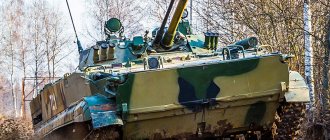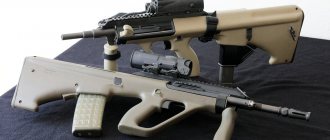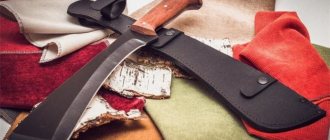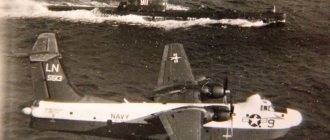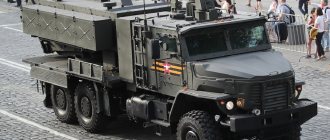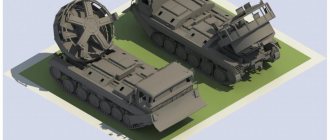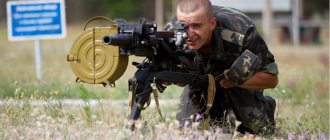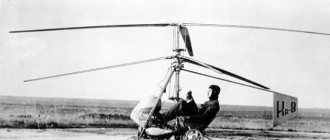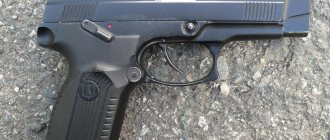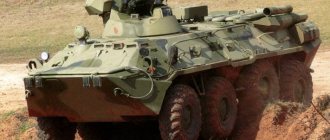Zefirka
> Weapons and army > Combat knives of Russian special forces
Despite the incredible development of modern military technologies, edged weapons still remain in service with the armies of all states on the planet. Particular attention is paid to equipping special forces units: here everyone has their own special knife designed to solve specific tasks. Russian special forces knives were developed taking into account the vast experience of designers, most of whom were directly involved in combat operations. This is what our fighters are doing to stop the enemy now.
"Shaitan"
This combat dagger was developed in 2001. The order was issued by the Ministry of Internal Affairs. Currently the series consists of two modifications. The first has a handle made of stacked leather. Double-sided sharpening of the leaf-shaped narrow blade allows you to perform the corresponding tasks quite effectively.
The serrator is also used for cutting slings. It is quite easy to cut a climbing rope with its help. The blade is capable of inflicting a deep cut wound. The handle and guard are made symmetrically. This knife is also used as a throwing weapon. It can withstand more than 3 thousand throws. Metal parts are subjected to anti-reflective treatment.
Peculiarities
The blade of the landing knife was made of stainless steel with nickel plating. Its length was 105 or 107 millimeters, the thickness of the butt was 4.0-4.2 mm. The design is of a non-separable type; the material’s high strength and corrosion resistance are also noted. The blade configuration was arrow-shaped, the heel on the right side was equipped with a lateral longitudinal protrusion.
The design of the weapon includes a pile in the form of an awl, aimed at untangling slings and knots and searching for mines. The specified tool was located in a folding compartment (length - 93 mm). This element was not equipped with a lock; it was held in an open position using the shape of the heel in the form of the English letter Z. The knife was carried in special pockets of parachute pants under the right knee of the equipment.
To remove the weapon, the fighter must unfasten the buttons and pull out the landing knife by the cord, which was fixed with one edge to the handle and the other to the jacket. Such a system made it possible to quickly remove the instrument, while simultaneously guaranteeing its safety. The main disadvantages of the product included the fuse spring, which often fails, and design features that complicate cleaning in the field.
"Storm"
This experimental model was created for the Marine Corps units of the Russian Armed Forces. When designing the knife, emphasis was placed on its versatility. In general, such daggers have always attracted a sufficient number of designers and engineers who are developing new models of edged weapons. However, solving a large number of problems with only one tool is something that is almost impossible to achieve in practice.
"Storm" is made of stainless steel. It has an inert, fairly impact-resistant handle, which allows it to be used effectively for its intended purpose. It is not possible to consider the dagger as a universal weapon, since it does not have saws. And there is no serrator on the blade. Therefore, this model can safely be called exclusively combat.
Finka NKVD
Russian special forces combat knives are created according to the same principle as this dagger. The war between the Soviets and Finland brought a lot of experience to the Union. During the war, shortcomings were identified that occurred in the ranks of intelligence officers. As is known, they operated behind enemy lines. This means they needed appropriate weapons and equipment.
One of the elements of equipment was a combat knife. It required versatility, thanks to which it could be used to solve as many purposes as possible. That is, they needed to silently destroy the enemy at the post, and equip a temporary cache, and make snowshoes from scrap materials, and much, much more.
By combining two bases at once (and we are talking about the base of a bayonet-knife, which was produced in 1919, and the Finnish scout knife), Soviet designers created an army knife, which later became known simply as NA-40. In Russia, “Finka” has been known since ancient times. She was very popular even before the revolution occurred. Legislation banned the use of Finnish knives in the 1930s.
However, engineers and gunsmiths slightly modified the “finka”, and on its basis a knife was created, which began to be used by the NKVD. That’s what they called him: “Finnish NKVD.” The second name for this weapon is a Norwegian-type knife. The dagger was issued on . The peak of production occurred precisely in the 40s.
"Sea Devil"
Some users ask the question: “What should a GRU special forces combat knife look like?” The “sea devil” dagger can provide an excellent answer to this question. As you know, experts did not stop at developing and adopting a bayonet for the Kalashnikov assault rifle, and therefore it was decided to develop improved weapons that could replace outdated ones in the elite troops.
“Sea Devil” is one of those knives used by Russian Marines, Airborne Forces and Special Forces. The designer of the knife is Igor Aleksandrovich Skrylev. He is the author of a large number of developments in this area. Many problems are solved with the help of this knife, and not only by special units of the Russian Navy (for which, in fact, the dagger was made).
"Chastener"
"The Punisher" is not just a knife. This is a whole series of them. It was made specifically for units of the Security Service, as well as for law enforcement units of the Ministry of Internal Affairs. This is what he is doing. Since 1994, it has been producing knives, which, it must be said, are quite high quality.
“The Punisher” is currently available in two variations. The first is “Maestro”, and the second is “Vzmakh-1”. They differ primarily in the material from which the handle is made. These are rubber, cardboard and leather. “Swing” has shivs in the root part. But at Maestro they are located at the top. These two models also differ in the type of sheath. Blades are also processed differently.
There is a double-sided guard. The blade is wide enough. Therefore, the knife can be used as a miniature shovel. On slopes it can be used as additional support. There is a crescent-shaped cavity on the cutting part. The weapon also comes with a sheath, which is made of high-quality leather. The knife was officially adopted into service in our country.
"Katran"
This series has its own characteristic features. For example, the material from which the handle is made, as well as the type of blade. The knives of the series are used for different purposes. These are not only underwater daggers, but also means for combat or survival. Everything, in general, depends solely on the modification of the knife.
The handle has a double-sided guard. The materials used for its production are leather, cardboard, and rubber. The blade has a one-and-a-half sharpening in the form of a wave-shaped saw. In the root part you can notice the presence of a hook. It is necessary to cut the meshes. There is also a serrator here.
Bayonet for Mosin rifle
Combat knives of the Russian GRU special forces began to be used quite a long time ago. Based on the bayonet that was used in conjunction with the Berdan rifle (and this event dates back to 1870), another tetrahedral bayonet was developed. He soon entered service with the Russian army.
In fact, the bayonet for the Mosin rifle, like the modern combat knives of the Russian GRU special forces, was simply a deadly weapon. The blade was half a meter long. With its help, a deep penetrating wound could be inflicted on the enemy. It was accompanied by rupture of internal organs, their severe damage, which led to the rapid death of the enemy.
The small entry hole left by the bayonet simply did not allow us to assess on the spot how serious the wound was. In most cases it was internal bleeding, as well as infection. All this ultimately led to death.
The bayonet for the Mosin rifle spent half a century in service. During this time, he practically did not change. The weapon experienced its peak during the Civil War and Revolution. It is worth noting that many Nazis were killed by Soviet troops using a bayonet. It became a kind of symbol that signified opposition to the fascists. Many posters that were made during this time reflect this fact.
Myths and reality
Can a throwing knife hit any target at a distance of 20 meters?
This myth arose thanks to films and books, because in them heroes throw weapons without looking and immediately hit the enemy. In fact, the maximum hitting distance is 9 meters.
Does it make a difference what to throw and from what distance?
It's very big! A knife weighing 150g or less is difficult to throw accurately at the target even for experienced people, so beginners may not even start with this. Plastic handles on weapons, windings, and balancers such as metal pommel are also excluded.
Throwing equipment
Do mercury knives exist?
The myth about mercury knives that stick into the target even for beginners is an old “fairy tale” that is replicated not only by amateurs, but even by professionals. No one has ever provided real evidence of the existence of such weapons.
Is it possible to throw only clearly balanced knives with a center of gravity in the middle?
There is actually little difference in terms of balancing. If the center of gravity is shifted to the handle, then the grip should be made straight on the blade, and when balancing closer to the blade, on the handle.
We recommend reading about the best hunting knives. From the article you will learn about the characteristics of a hunting knife, sizes for hunting, selection rules for fishing, hunting and tourism, ranking among the best knives in the world. And here is more information about the best throwing knives for beginners and professionals.
There are several knife throwing techniques, each of them has individual characteristics, but is suitable for beginners. It is enough to purchase equipment and set a goal to learn how to accurately throw a weapon - and the results will appear after just a few training sessions.
